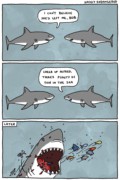Can you guess what it is that sharks turn inside out?
Seeing sharks close by gives me butterflies in my stomach (wait… that’s love?), okay then they make my stomach growl (nope, that’s when I’m hungry)… Oh, I got it! Sharks turn my stomach inside out. No! They turn their own stomachs inside out… They can’t actually vomit instead they do something similar to vomiting: gastric eversion. This is where the stomach relaxes and oesophagus contracts to “clean” any indigestible food like licence plates, parasites or bones from the stomach lining.
Let’s take a look at how a shark digests its lovely not broken seal prey.
The digestive system can be separated into four sections: the oral cavity; the foregut; midgut and the hindgut.

-
The Oral Cavity
The oral cavity is basically the mouth section consists of those lovely pearly whites, mouth, and pharynx. Here there are no digestive juices secreted, as the shark does not chew his food so the food does not need to be digested for swallowing.
-
Foregut
The foregut is composed of the oesophagus and stomach.
The oesophagus the oral cavity, i.e. the mouth and pharynx to the stomach. This stops the food from exiting the mouth as they have striated muscles to stretch to the size of the prey for swallowing. Imagine a seal being swallowed and not able swim to out… Yikes! The oesophagus looks like thousands of extended fingers.
The second half of the foregut is the stomach (hmmm yummy, yummy, yummy I got love in my tummy!). This is where the food is stored and digestion happens. So, strong stomach acids and enzymes such as gastric acid and pepsinogen are used to digest the food.
*Interesting fact*: Their stomachs are U-shaped!
The foregut and midgut are connected by a small control device called the pyloric valve. Only mush is pushed through there because the stomach acid dissolves the stomach contents.
-
The Midgut
The midgut is composed of two sections, the small intestine, and large intestine.
T small intestine has the duodenum and ileum – which is similar to a human but the large intestine is actually shaped like a screw. It is twisted in this shape, as there is more surface area to aid in absorption and increase digestion. Most of the nutrients are absorbed in the midgut.
-
The Hindgut
The hindgut is where all the poopie comes out. Like a mullet, its business in the front and party in the back.
The large intestine is connected to the colon as a continuation of the small intestine. This is then connected to the rectum and cloaca that collects waste from the colon and the rest is “history”
Honestly, I don’t think I can “stomach” picturing this “gut” reaction.
By Kylie Samuels






